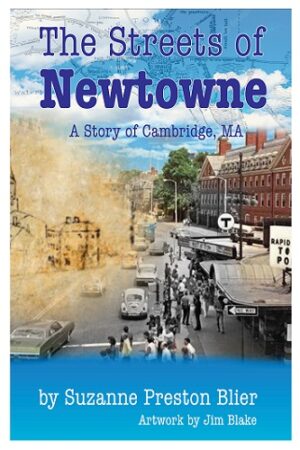Streets of Newtowne addresses the broader history of Newtowne (Cambridge, Massachusetts).
While this is the story of one town (my town today), it is also the story of our country. Each chapter features one or more key figures in the telling of this story – from the female Native chief, Sqa Sachem (“Female Ruler”) who met the first pilgrim settlers, to Anne Hutchinson and others who fled the rigidity of the town’s religious and civic rules, to the wealthy slave and plantation owners here, to the Boston Tea Party participants and the arrival of George Washington to take command of the army, to the evacuation of the Loyalists, to the Civil War and the battle within the city between local elites and new émigrés, to the city’s growing importance as a technology center. Every path, street, and water route at this important center held onto its memories of important events that unfolded on or near these critical routes of communication, action, and change. The imagery and text of Streets of Newtowne together
harness this rich history offering a unique verbal and visual narrative that is both compelling and easy to grasp. Each chapter focuses on key conflicts and challenges that the city has faced over its long history –from religious fundamentalism to the primacy of local political voices, to the challenges of a new and largely émigré community, to issues around over-development and climate crisis.
While this book features many of the core conflicts as well as the well-known men who helped to shape this area – from Paul Revere and George Washington to Henry Wadsworth Longfellow and the blacksmith, Dexter Pratt, special attention is given to the native land holders, from the female chief who ruled the region at the time the pilgrims arrived and signed the early deeds, along with Caleb Cheeshahteamuck, the first Native American graduate of Harvard College. Women figured prominently here, among these, Anne Bradstreet (America’s first poet) and Anne Hutchinson, the local midwife who pushed for more religious freedom and after her heresy trial was banished from the city taking many religious followers with her. Important in Streets of Newtowne too are various people of African descent. One was Onesimus, the enslaved African, gifted to Puritan minister, Cotton Mather, who offered insights on African smallpox inoculation practices, saving many lives. Another was the enslaved and then freed Darby Vassall who greeted George Washington at the gates of his Vassall estate home (now on Brattle Street) after his Loyalist owners fled the city. Darby later would purchase his own home in Cambridge and work as a caterer. Still another is African American author, Harriet Jacobs, who owned and ran a boarding house in Cambridge not far from the first market. Cambridge now faces serious crises – environmental, affordable housing, over development with labs. The book concludes with a return to our native beginnings and ask the reader (and residents to decide: where do we go from here?














Reviews
There are no reviews yet.